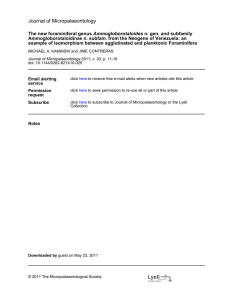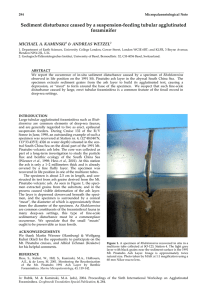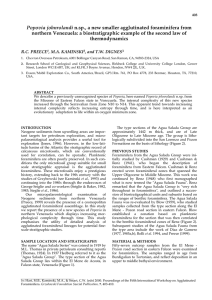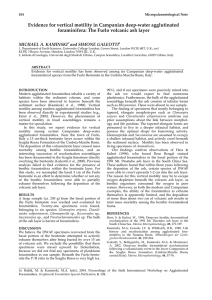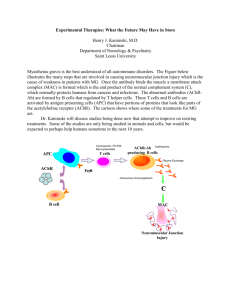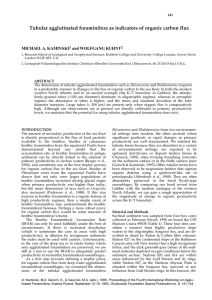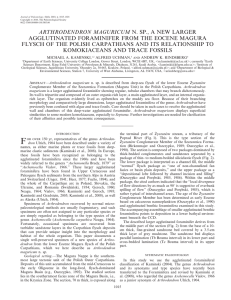Document 13876689
advertisement
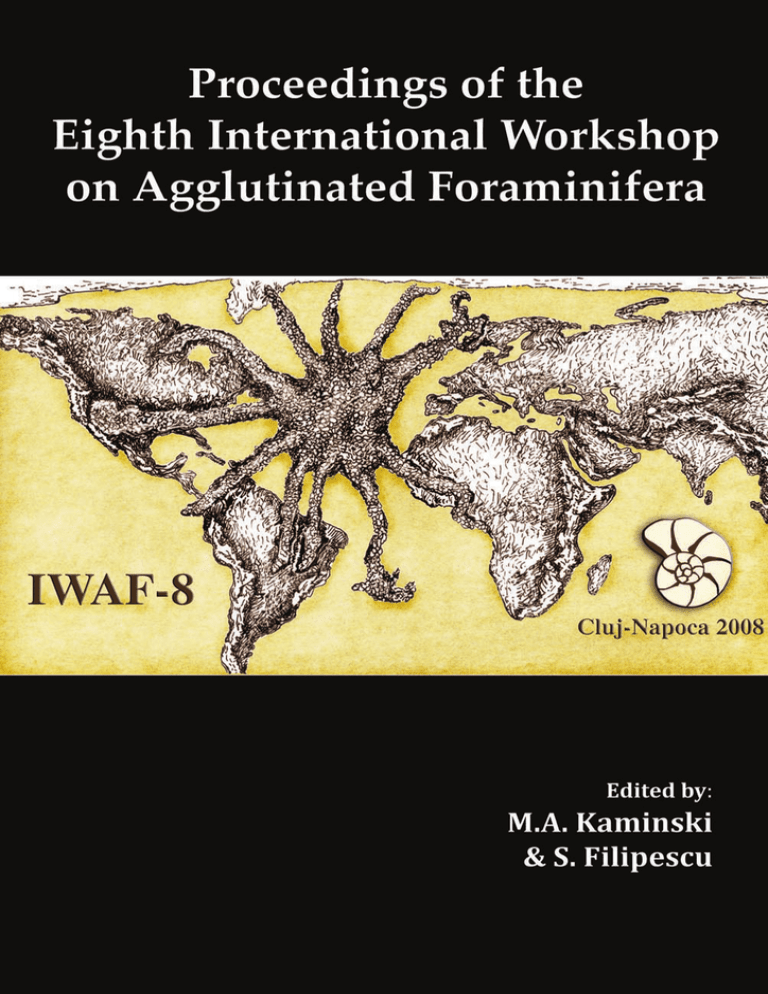
Proceedings of the Eighth International Workshop On Agglutinated Foraminifera (Cluj-Napoca, Romania, September 7-13, 2008) Edited by Michael A. Kaminski Earth Sciences Department, King Fahd University of Petroleum & Minerals, Dhahran, 31261, Saudi Arabia and Sorin Filipescu Department of Geology, Babeș–Bolyai University, Str. Kogălniceanu 1, Cluj-Napoca, 400084, Romania Published by The Grzybowski Foundation Grzybowski Foundation Special Publication No. 16 53 The New and Reinstated Genera of Agglutinated Foraminifera published between 2005 and 2008 MICHAEL A. KAMINSKI Department of Earth Sciences, University College London, Gower Street, London WC1E 6BT, U.K.; Current address: Earth Sciences Department, King Fahd University of Petroleum & Minerals, Dhahran, 31261, Saudi Arabia; e-mail: kaminski@kfupm.edu.sa ABSTRACT During the four-year period since the publication of the previous Proceedings of the International Workshops on Agglutinated Foraminifera, some seven genera of agglutinated foraminifera have been described as new, one genus has been reinstated, one newly described genus has been suppressed, and 10 schlumbergerinid and 15 xenophyophorid genera have been transferred to the agglutinated foraminifera. This brings the total number of new, reinstated, and reassigned agglutinated foraminiferal genera to 185 since the publication of “Foraminiferal Genera and their Classification” by Loeblich & Tappan (1987). INTRODUCTION The purpose of this paper is to continue the compilation of validly described and reinstated genera of agglutinated foraminifera published after Loeblich & Tappan’s (1987) book “Foraminiferal Genera and their Classification”. In this paper, I provide a list of the newly described genera of agglutinated foraminifera published in the accessible literature, as well as those that have been newly reinstated, or transferred to the agglutinated foraminifera. The current work is a continuation of previous compilations containing 152 valid genera (Kaminski, 2000, 2004a, 2008), and encompasses the years 2005 to 2008, inclusive. It is my intention to update these "appendices" to Loeblich & Tappan (1987) approximately every four years as a regularly occurring chapter in the IWAF proceedings volumes. The purpose of this work is to review recent changes and updates to the taxonomy with the goal of stabilising the generic nomenclature of the agglutinated foraminifera. The suprageneric systematics of the genera follows Kaminski (2004b), with the exception the latinised endings for the superfamilies have now been corrected to follow zoological rather than botanical nomenclature. Genera reinstated or transferred into the Agglutinated Foraminifera since 2005 Subclass TEXTULARIIA Mikhalevich, 1980 Order ASTRORHIZIDA Lankester, 1885 Suborder ASTRORHIZINA Lankester, 1885 Superfamily XENOPHYOPHOROIDEA Tendal, 1972 [stat. nov. ex subclass Xenophyophoria Tendal, 1972]. The recent findings that at a molecular level, at least some species of xenophyophores are in fact foraminiferans closely related to Rhizammina (Pawłowski et al., 2003; A. Gooday, personal communication, 2008) means that their systematics must be accommodated within the subclass Textulariia in the classification of Kaminski (2004b). At best, this group can be assigned equal status among the two existing superfamilies Astrorhizoidea Brady, 1881, and Komokioidea Tendal & Hessler, 1977 within the suborder Astrorhizina Lankester, 1885. The following genera are members of the superfamily Xenophyophoroidea: Aschemonella Brady, 1879, Cerelasma Haeckel, 1889, Cerelpemma Laubenfels, 1936, Galatheammina Tendal, 1972, Homogammina Gooday & Tendal, 1988, Maudammina Tendal, 1972, Occultammina Tendal, Swinbanks & Shirayama, 1982, Psammetta Schultze, 1906, Psammina Haeckel, 1889, Reticulammina Tendal, 1972, Semipsammina Tendal, 1975, Spiculammina Kamenskaya, 2005, Stannoma Haeckel, 1889, Stannophyllum Haeckel, 1889, and Syringammina Brady, 1883. The genus Pelosina Brady, 1879 was regarded by Mikhalevich & Voronova (1999) to be a xenophyophore, but according to A. Gooday (personal communication, 2010), the genus does not possess any of the distinctive internal features (granellare strands or stercomare strings) that characterise the subfamily. Pelosina is therefore best placed in the superfamily Saccamminoidea. SCHLUMBERGERINIDA Mikhalevich, 1980 (= order Rzehakinida Saidova, 1981 = suborder Rzehakinina Saidova, 1981 in the classification of Kaminski, 2004b) In: Kaminski, M.A. & Filipescu, S., (eds), 2011. Proceedings of the Eighth International Workshop on Agglutinated Foraminifera. Grzybowski FoundationSpecial Publication, 16, 53-59. 54 M.A. Kaminski The taxonomic position and the composition of the order Schlumbergerinida Mikhalevich, 1980 has been reviewed by Mikhalevich & Kaminski (2008). The schlumbergerinids represent a well-defined foraminiferal group characterised by the predominance of planispiral or miliolid coiling modes not seen in other foraminiferal phyletic lines except within the class Miliolata. They differ from their isomorphic forms within the subclass Miliolana in the agglutinated character of their wall (mainly agglutinated on an organic base). Genera having a thick agglutinated layer underlain by a thin calcareous layer characteristic of the porcellaneous miliolids were also included in the order Schlumbergerinida by Mikhalevich & Kaminski (2008). In the classification of Kaminski (2004b), the Rzehakinina was regarded as a suborder of the Lituolida, with ten genera (Psamminopelta Tappan, 1957, Rzehakina Cushman, 1927, Spirolocammina Earland, 1934, Ammoflintina Earland, 1934, Birsteiniolla Mayer, 1974, Miliammina Heron-Allen & Earland, 1930, Silicomassilina Serova, 1966, Silicosigmoilina Cushman & Church, 1929, Spirosigmoilinella Matsunaga, 1955, and Trilocularena Loeblich & Tappan, 1955). In addition to the abovelisted genera Mikhalevich & Kaminski (2008) transferred the following genera into the order Schlumbergerinida: Spiroglutina Mikhalevich, 1983 (type species: Spiroloculina asperula Karrer, 1868). Agglutinella El-Nakhal, 1983 (type species: Agglutinella soriformis El-Nakhal, 1983). Dentostomina Carman, 1933 (type species: Dentostomina bermudiana Carman, 1933). Siphonaperta Vella, 1957 (type species: Siphonaperta macbeati Vella, 1957). Falsagglutinella Loeblich & Tappan, 1994 (type species: Falsagglutinella byrsa Loeblich & Tappan, 1994). Ammomassilina Cushman, 1933 (type species: Massilina alveoliniformis Millett, 1898). Ammosigmoilinella Zheng, 1988 (type species: Ammosigmoilinella eximia Zheng, 1988). Sigmoilopsis Finlay, 1947 (type species: Sigmoilina schlumbergeri Silvestri, 1904). Schlumbergerina Munier-Chalmas, 1882 (type species: Schlumbergerina arenifora Munier-Chalmas, 1882). Pseudoflintina Saidova, 1981 (type species: Miliolina triquetra Brady, 1879). HORMOSININA Mikhalevich, 1980 ARTHRODENDRON Ulrich, 1904 Type species. Arthrodendron diffusum Ulrich, 1904, p. 138, OD. [Subjective junior synonym: Aschemonella carpathica Neagu, 1964, p. 582]. Arthrodendron Ulrich, 1904, p. 138, OD. Halysium Świdziński, 1937, p. 146 [type species: Halysium problematicum Świdziński, 1934; non Halysium Corda, 1837]. Palaeoarthrodendron Dayal, 1964, p. 727 [nom. subst. pro Arthrodendron Ulrich, 1904]. Aschemocella Vialov, 1966, p. 31. [type species: Aschemonella carpathica Neagu, 1964]. Test free, with large (commonly 1–3 mm wide) irregularly ovoid, flask-shaped, or tubular chambers in a linear or dichotomously branching series, increasing very slowly in size. Chambers are compressed with a raised outer rim and may have irregular shape at the point of branching. Wall imperforate, simple, of agglutinated quartz, mica, and sponge spicules in abundant cement, probably with an inner organic lining. May have more than one rounded aperture, which may be produced on a neck, terminal, or may be at the side of the chamber, probably just before a new branch arises. U. Cretaceous (Campanian); Romania, Ukraine; Paleogene, Trinidad, Angola, North Sea. Figure 1. Arthrodendron diffusum Ulrich. Upper Cretaceous, Kodiak Island, Alaska, Paratype, natural size (from Ulrich, 1904). Remarks. We regard the type species of the genus Aschemocella (Aschemonella carpathica Neagu, 1964) to be a junior synonym of Arthrodendron diffusum (Kaminski et al. 2008). Kaminski, M.A., Uchman, A., Neagu, T. & Cetean, C.G. 2008. A larger agglutinated foraminifer originally described as a marine plant: The case of Arthrodendron Ulrich, 1904 (Foraminifera), its synonyms and homonyms. Journal of Micropalaeontology. 27 (2), 103-110. Genera suppressed since 2005 ORBITOLININA Kaminski, 2004b PRAEORBITOLINOIDES Matsumaru, 2005 Cherchi & Schroeder (2009) regarded the genus Praeorbitolinoides Matsumaru, 2005 to be a junior The New and Reinstated Genera of Agglutinated Foraminifera published between 2005 and 2008 synonym of Praeorbitolina, based upon their reinterpretation of the juvenile stage of the type species Praeorbitolinoides japonica Matsumaru, 2005. According to these authors, Praeorbitolinoides japonica represents a transitional form between the species Praeorbitolina cormyi and Praeorbitolina wienandsi Schroeder. Matsumaru, K. 2005. Praeorbitolinoides, a new orbitolinid foraminiferal genus from the Lower Aptian (Cretaceous) of Hokkaido, Japan. Micropaleontology, 51 (1), 93-99. Cherchi, A. & Schroeder, R. 2009. Revision of the orbitolinid foraminiferal genus Praeorbitolinoides Matsumaru, 2005 from the Aptian of Hokkaido, Japan. Micropaleontology, 55 (4), 421-424. New Genera published since 2005 ALLOGROMIIDA Hartog in Harmer & Shipley, 1906. CONICOTHEKA Gooday, Todo, Uematsu & Kitazato, 2008 Type species. Conicotheca nigrans Gooday, Todo, Uematsu & Kitazato, 2008, OD Conicotheca Gooday, Todo, Uematsu & Kitazato, 2008, p. 416. Description. Test tiny (usually <120 microns), elongate, more or less conical in shape, tapering towards the proximal end from widest point in the distal third to quarter. Proximal end often slightly bulbous; distal end truncated or bluntly pointed with single terminal aperture that is round to elongated in shape. There are no internal subdivisions. Test wall mainly organic, transparent and colourless. Some areas smooth on submicrometre scale; other areas with scale-like surface pattern, probably due to the presence of clay minerals. Test interior contains large, dark coloured stercomata. Holocene, NW Pacific, at 10,896 m. Figure 2. Conicotheca nigrans Gooday, Todo, Uematsu & Kitazato. Holocene, NW Pacific, CHALLENGER Deep, southwest part of the Izu–Bonin–Mariana Trench (11°20.093′N, 142°11.803′E, depth 10,896 m). Side view of holotype (MPC-02704), Transmission light micrograph of specimen on open slide in glycerol, scale = 25 µm (from Gooday et al. 2008). Remarks. Differs from Nodellum in its much smaller test size, more compact, streamlined shape, and in the lack of a well defined proloculus. Conicotheca differs from Resigella in the absence of chamber-like subdivisions. The type specimens of C. nigrans are 55 deposited in the Micropalaeontology Collection, National Museum of Nature and Science, Tokyo and in the Palaeontology Department, Natural History Museum London under reg. nos. MPC-02704 (holotype), MPC-02699-02703 (five paratypes) and BMNH ZF 5168 (six paratypes). Gooday, A.J., Todo, Y., Uematsu, K. & Kitazato, H. 2008. New organic-walled Foraminifera (Protista) from the ocean’s deepest point, the Challenger Deep (western Pacific Ocean). Zoological Journal of the Linnean Society, 153 (3), 399–423. KOMOKIOIDEA Tendal & Hessler, 1977 BACULELLIDAE Tendal & Hessler, 1977 SKELETONIA Gooday, Kamenskaya & Cedhagen, 2007 Type species. Skeletonia variabilis Gooday, Kamenskaya & Cedhagen, 2007; OD(M). Skeletonia Gooday, Kamenskaya & Cedhagen, 2007, p. 244. Description. Test consisting of an initial cluster of globular, grape-like or more elongate chambers followed by a small number of relatively wide, stiff, crooked, tubular processes, typically 80–100 µm in diameter. These usually arise from either side of the longitudinal growth axis and increase in length from proximal to distal. The growth axis is sometimes compressed, obscure, or lacking. Tubular processes are sometimes interrupted by internal septa, and most of them branch dichotomously once or twice. The tips of the processes are flattened or rounded. Holocene; Southern Ocean, at 4,927–4,932 m. Figure 3. Skeletonia variabilis Gooday, Kamenskaya & Cedhagen. Holocene, Weddell Abyssal Plain, Southern Ocean, at 4,927–4,932 m. Side view of holotype (SMF XXVII 7533) in transmitted light, scale = 500 µm (from Gooday et al., 2007). Remarks. The test of Skeletonia consists of a series of elongate elements termed “tubular processes” because they are wider than the tubules of typical 56 M.A. Kaminski komokiaceans. The genus is reminiscent of Baculella, but differs in the lack of an axial tubule. Instead, the axis, where present, is formed by the bases of the lateral tubular processes and the short, stolon-like necks that connect them. The tubular processes are larger and more robust than the bead-like chambers of Baculella. Gooday et al. (2007) did not place the genus in the Baculellidae, but regarded it to be a komoki incertae sedis. The type species displays considerable variability in that the arrangement of the tubular processes are not consistent. In some individuals there is an apparent axis of growth, but in others this axis is irregular and is compressed or not visible at all. The initial part, where visible, consists of a cluster of globular chambers but in some specimens these are replaced by small tubular structures. Type specimens of Skeletonia variabilis are housed in the Senckenberg Museum, Frankfurt (SMF XXVII 7533-7534). peripheral tubes, and is branched and rarely anastomosing. Branching is dichotomous and trichotomous, occurring in clusters along the trunk of the tube. Xenophyae consist of sponge spicules oriented outwards chaotically, giving the test a shaggy appearance. Interior of tubes is filled with strings and masses of granellare and stercomare, with sparse xenophyae. Remarks. As in other genera of the Psamminida, Spiculammina possesses external xenophyae arranged in a surface layer, while the chamber interior contains a loose mass of xenophyae with granellare and stercomare between them. The genus most closely resembles Reticulammina, differing in having a more treelike shape with large central trunk and sparse branching. The single intact specimen and numerous fragments were collected at a depth of 5400 m on the abyssal plain at the Clipperton Fracture Zone in the Pacific (11°52.1’N, 136°06.3’W). Gooday, A.J., Kamenskaya, O.E. & Cedhagen, T. 2007. New and little-known Komokiacea (Foraminifera) from the bathyal and abyssal Weddell Sea and adjacent areas. Zoological Journal of the Linnean Society, 151, 219-251. Kamenskaya, O.E. 2005. Spiculammina delicata gen. et sp.n., a new xenophyophore from the eastern Pacific (Psamminidae). Invertebrate Zoology, 2 (1), 23-27. XENOPHYOPHOROIDEA Tendal, 1972 PSAMMINIDAE Haeckel, 1889 SPICULAMMINA Kamenskaya, 2005 Type species. Spiculammina delicata Kamenskaya, 2005, OD(M). Spiculammina Kamenskaya, 2005, p. 24. VERNEUILINOIDEA Cushman, 1911 PROLIXOPLECTIDAE Loeblich & Tappan, 1985 EOBIGENERINA Cetean, Setoyama, Kaminski, Neagu, Bubík, Filipescu & Tyszka, 2008 Type species. Bigenerina variabilis Vašíček, 1947, OD. Eobigenerina Cetean, Setoyama, Kaminski, Neagu, Bubík, Filipescu & Tyszka, 2008, p. 6. Figure 5. Eobigenerina variabilis (Vašiček). Upper Cretaceous (Cenomanian), Hluk Formation, Hluk village, Czech Carpathians. Left: holotype. Remaining specimens are paratypes, side and top views, length of holotype = 0.45 mm (from Vašíček, 1947). Figure 4. Spiculammina delicata Kamenskaya, 2005. Holocene, Pacific Ocean, Clipperton Fracture Zone, R/V Antropov Sta. 5458, 5400m depth, lateral view of holotype (Zoological Museum, Moscow State University, nr. F-13), scale = 10 mm (from Kamenskaya, 2005). Test large, up to 40 mm in height, treelike, probably attached, consisting of tubes of differing diameters. The central tube is 3 to 5 times thicker than Description. Test with an early biserial stage comprising at least one-third the length of the adult test, followed by a loosely biserial stage, then a short lax uniserial portion, and finally by a terminal uniserial stage of low chambers that are round in cross-section. Wall solid, noncanaliculate, finely finished, of fine agglutinated particles in organic material, often well-silicified, insoluble in HCI. Aperture terminal, small and rounded, on a collar or The New and Reinstated Genera of Agglutinated Foraminifera published between 2005 and 2008 short neck. Australia; North Atlantic; Barents Sea; Alpine-Carpathian region: Romania, Poland, Czech Republic, Austria. Remarks. Differs from Bigenerina in having a solid, noncanaliculate wall that is insoluble in acid, and from Aaptotoichus in having a well-developed biserial part, an apertural neck, and a finely agglutinated test wall. It differs from Bimonilina in having chambers that are truly uniserial, rather than lax-uniserial, and in having a round terminal aperture. Differs from Rashnovammina and Bicazammina in the addition of a truly uniserial terminal part with horizontal sutures between last chambers. Numerous Mesozoic species originally described as Bigenerina possess a solid noncalcareous wall and should be transferred to this genus (see Cetean et al., this volume). Vašíček, M. 1947. Poznámky k mikrobiostratigrafii magurského flyše na Moravě. Věstník Státního Geologického Ústavu Československé Republiky, 22, 235-256. Cetean, C.G., Setoyama, E., Kaminski, M.A., Neagu, T., Bubík, M., Filipescu, S. & Tyszka, J. 2008. Eobigenerina n.gen., a cosmopolitan deep-water agglutinated foraminifer, and remarks on species formerly assigned to the genera Pseodobolivina and Bigenerina. In: Filipescu, S. & Kaminski, M.A. (eds), Eighth International Workshop on Agglutinated Foraminifera, Abstract volume. Grzybowski Foundation Special Publication, 14, 6-7. RECTOPROTOMARSSONELLA Kaminski, Bubík & Cetean, 2008 Type species. Marssonella rugosa Hanzlíková, in Homola & Hanzlíková 1953, OD(M). Rectoprotomarssonella Kaminski, Bubík & Cetean, 2008, p. 517. 57 mostly indistinct, slightly depressed. Wall coarsely agglutinated, noncanaliculate, with sparse calcareous cement, comprised of coarse particles held in a finegrained groundmass. Aperture initially interiomarginal, a low slit situated in a re-entrant at the base of the last chamber, moving to terminal position in the uniserial part, rounded, without a tooth. Carpathians (Poland, Czech Republic, Romania); Spain. Remarks. This genus differs from Protomarssonella Desai & Banner 1987 in possessing a uniserial part. It differs from the Cenozoic genus Goesella in having a solid wall and in lacking any trace of an apertural tooth. A single specimen of the type species, Marssonella rugosa is preserved in the Hanzlíková collection at the Czech Geological Survey. The specimen slide is labeled “holotype”, but it is not from the type locality, and must have been added to the collection at a later date. Acid treated specimens display holes in the wall where calcareous grains have been dissolved away, but no sign of a regular pattern of rounded pseudopores as in the genus Marssonella (see Desai & Banner 1987). The first chambers of the uniserial part still display some aspect of biseriality, and can be described as “lax-uniserial”, while later chambers are truly uniserial, with horizontal sutures. Kaminski, M.A., Bubík, M. & Cetean, C.G. 2008. Rectoprotomarssonella n.gen., a new agglutinated foraminiferal genus from the Upper Cretaceous of the Carpathian flysch. Micropaleontology, 53 (6), 517-521 [for 2007]. ORBITOLININA Kaminski, 2004b PFENDERINOIDEA Smout & Sugden, 1962 HAURANIIDAE Septfontaine, 1988 AMIJELLINAE Septfontaine, 1988 ALZONORBITOPSELLA BouDagher-Fadel, 2008 Type species. Alzonorbitopsella arabia BouDagherFadel, 2008, OD(M). Alzonorbitopsella BouDagher-Fadel, 2008. p. 175. Figure 6. Rectoprotomarssonella rugosa (Hanzlíková). Upper Cretaceous (Campanian), Czech Republic. Side view of the so-called “False Holotype” from the Hanzliková Collection, Czech Geological Survey, Prague, scale = 100 µm (from Kaminski et al. 2007). Description. Test large, elongate, up to 1 mm in length, tapering toward the base, and later nearly cylindrical in section, with a flattened terminal face. Early stage trochospirally coiled with four to five chambers per whorl, later reduced to triserial, biserial, and finally uniserial. Chamber interior not subdivided. Sutures Figure 7. Alzonorbitopsella arabia BouDagher-Fadel. Middle Jurassic, Uweinat Formation of Saudi Arabia, equatorial section of presumed holotype, x20, (from BouDagher-Fadel, 2008). 58 Description. Test planispiral, annular and discoidal with no septulae. Septa simple, lacking a subepidermal reticulate mesh, thickened around the cribrate apertures, lacking true pillars linking septum to septum. A delicate reticulate hypodermis of beams and rafters is present, but this structure does not continue onto the septa. Chambers annular immediately following the large megalospheric proloculus. Apertures cribrate. Saudi Arabia. Remarks. Differs from Orbitopsella in lacking true pillars linking the septa. BouDagher-Fadel (2008) described the type species from the Uweinat Formation of Saudi Arabia. BouDagher-Fadel, M. 2008. Evolution and geological significance of larger benthic foraminifera. Developments in Palaeontology & Stratigraphy, 21, 540 pp. ORBITOLINOIDEA Martin, 1890 ORBITOLINIDAE Martin, 1980 DICTYOCONINAE Moullade, 1965 BARATTOLITES Vecchio & Hottinger, 2007 Type species. Barattolites trentinarensis Vecchio & Hottinger, 2007, OD(M). Barattolites trentinarensis Vecchio & Hottinger, 2007, p. 520. M.A. Kaminski beams) irregularly alternating or in line from one chamber to the next. The endoskeleton consists of columnar free-standing pillars positioned in the adaxial zone, delimited by a marginal trough and in line from one chamber to the next. The early growth stages in a megalospheric specimen consist of an excentric proloculus followed by a hemispherical deuteroconch and by a trochospiral nepiont that has a coiling axis, that may be considerably inclined, or even perpendicular with respect to the axis of the adult cone. In a microspheric specimen, the microsphere is found in an even more eccentric position followed by a tightly coiled nepiont exhibiting at least four whorls. During early ontogeny, the exoskeleton seems to appear first, the endoskeleton shortly afterwards. L-M. Eocene, Italy. Remarks. Barattolites differs from Dictyoconus Blanckenhorn, 1900, in its simple exoskeleton, lacking horizontal partitions (rafters). It differs from the genus Fallotella Mangin, 1954, in its eccentrically positioned megalosphere, and its lack of horizontal partitions (rafters). It differs from the genus Daviesiconus Hottinger & Drobne, 1980, in having a long trochospiral early growth stage, in the absence of marginal apertures, and the constant occurrence of intercalary beams. Coleiconus Hottinger & Drobne, 1980, differs in exhibiting a pseudo-keriothecal texture in the thick outer chamber walls and in its lack of intercalar beams. Vecchio, E. & Hottinger, L. 2007. Agglutinated conical foraminifera from the Lower-Middle Eocene of the Trentinara Formation (southern Italy). Facies, 53, 509-533. ACKNOWLEDGEMENTS The revision of agglutinated foraminiferal genera is supported by a consortium of petroleum companies and micropalaeontological consultancies (BP, Chevron, Saudi Aramco, Shell, Total, PDVSA, RPS Energy, Fugro Robertson Ltd., Petrobras and Petronas). We thank Alla Mihkalevich (RAS), Claudia Cetean (NHM), and Andy Gooday (SIO) for their help and for reviewing the manuscript. This is contribution nr. 95 of the Deep-Water Agglutinated Foraminiferal Project. Figure 8. Barattolites trentinarensis Vecchio & Hottinger, 2007. Ypresian–Lower Lutetian, Trentinara Formation, Mount Panno Bianco (Pollino Massif, Calabria, southern Italy. Section parallel to cone axis; p-pillar, s-septum, fforamen, b-beam. Holotype, megalospheric form, x30 (from Vecchio, & Hottinger, 2007). Description. Test high conical. Chamber arrangement trochospiral in early stage, uniserial in later stages. Cone base almost flat in early stage, distinctly convex in adult chambers. Exoskeleton consisting of simple radial partitions (beams and intercalary ADDITIONAL REFERENCES Kaminski, M.A. 2000. The New and Reinstated Genera of Agglutinated Foraminifera published between 1986 and 1996. In: Hart, M.B., Kaminski, M.A. & Smart, C.W. (eds), Proceedings of the Fifth International Workshop on Agglutinated Foraminifera. Grzybowski Foundation Special Publication, 7, 185-219. Kaminski, M.A. 2004a. The new and revised genera of agglutinated foraminifera published between 1996 and 2000. In: Bubík, M. & Kaminski, M.A. (eds), Proceedings of the Sixth International Workshop on The New and Reinstated Genera of Agglutinated Foraminifera published between 2005 and 2008 Agglutinated Foraminifera. Grzybowski Foundation Special Publication, 8, 257-271. Kaminski, M.A. 2004b. The Year 2000 classification of agglutinated foraminifera. In: Bubík, M., & Kaminski, M.A., (eds), Proceedings of the Sixth International Workshop on Agglutinated Foraminifera. Grzybowski Foundation Special Publication, 8, 237-255. Kaminski, M.A. 2008. The new and reinstated genera of agglutinated foraminifera published between 2000 and 2004. In: Kaminski, M.A. & Coccioni, R. (eds), Proceedings of the Seventh International Workshop on Agglutinated Foraminifera. Grzybowski Foundation Special Publication, 13, 47-55. Loeblich, A.R. & Tappan, H. 1987. Foraminiferal Genera and their Classification. Van Nostrand Reinhold. 970 pp + 847 pls. 59 Mikhalevich, V. & Kaminski, M.A. 2008. Revised systematics of the Schlumbergerinida (Phylum Foraminifera). In: Kaminski, M.A. & Coccioni, R. (eds), Proceedings of the Seventh International Workshop on Agglutinated Foraminifera. Grzybowski Foundation Special Publication, 13, 157-166. Mikhalevich, V.I. & Voronova, M.N. 1999. On the taxonomic position of the genus Pelosina (Xenophyophoria, Protista, Inc. Sedis). Zoologicheskiy Zhurnal, 78 (2), 133-141 [in Russian]. Pawłowski, J., Holzmann, M., Fahrni, J. & Richardson, S.L. 2003. Small subunit ribosomal DNA suggests that the xenophyophorean Syringammina corbicula is a foraminiferan. Journal of Eukaryotic Microbiology, 50 (6), 483-487.
